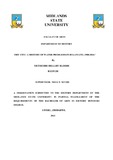Please use this identifier to cite or link to this item:
https://cris.library.msu.ac.zw//handle/11408/2071| Title: | Dry city: a history of water problems in Bulawayo, 1980-2014. | Authors: | Hadebe, Methembe Hillary | Keywords: | Water scarcity, Bulawayo Zimbabwe | Issue Date: | 2015 | Publisher: | Midlands State University | Abstract: | Bulawayo has struggled with water scarcity since its inception in 1894 and even after the independence of Zimbabwe in 1980. The irony was that while the City of Bulawayo celebrated 120 years of existence in 2014, water scarcity challenges were still a living memory and a reality - a situation that has witnessed its residents living without water, the industries struggling without water and even the authorities’ witch hunting a more feasible and sustainable solution to end water shortages. Although other cities in Zimbabwe have experienced water paucity problems in a similar fashion, Bulawayo finds herself with a different water scarcity version were water deficits are perceived to be a direct conspiracy by the Shona dominated government against a perceived Ndebele dominated city. Put in other words, the perceived ethnic tensions have made Bulawayo a dry city, ultimately propelling untold sufferings on the livelihoods and suffocating industries out of Bulawayo. (Beneath these controversies and conspiracies they are a number of factors that account for Bulawayo’s incessant water shortages which include the geographical location of the city, population density straining resources, obsolete water supply infrastructure, the decommissioning of dams, financial constraint and lack of resources to explore reservoirs.) In the midst of water scarcity the government, the BCC and the non-state actors sought solutions that have reduced water shortages, but have failed to fully realize water sanity and security. The first chapter looks at the impact of water shortages on the livelihood of Bulawayo. It spells out the survival, mitigation and coping strategies of people without water. The second chapter provides solutions that the BCC, the government and non-state actors have deployed to mitigate water woes. Chapter three presents the history of the MZWP paying particular attention to its history and its controversial episodes that have delayed the implementation. Chapter four deals with the discourse of water and de-industrialization, particularly locating water in the contemporary debate of industrial relocation from Bulawayo. Nonetheless, the study used a qualitative research and proved that water scarcity of Bulawayo has been used for different scores by various organisations and thus created a new social order. | URI: | http://hdl.handle.net/11408/2071 |
| Appears in Collections: | Bachelor Of Arts In History Honours Degree |
Files in This Item:
| File | Description | Size | Format | |
|---|---|---|---|---|
| mayor final pdf.pdf | Full Text | 1.84 MB | Adobe PDF |  View/Open |
Page view(s)
308
checked on Dec 3, 2025
Download(s)
238
checked on Dec 3, 2025
Google ScholarTM
Check
Items in MSUIR are protected by copyright, with all rights reserved, unless otherwise indicated.



